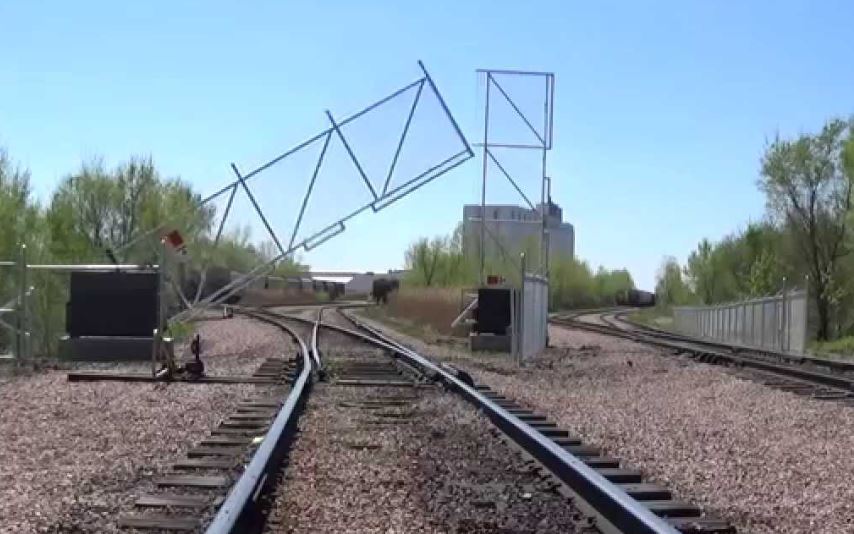Vertical Pivot Gates

Automated gates are an essential installation for commercial and industrial facilities, providing sturdy barricades while granting entry to authorized personnel. Choosing the right type of automated gate requires careful thought, as the barriers must be properly aligned with surrounding terrain. Generally speaking, we don’t recommend swing and slide gates for entrances obstructed by curbs, drainage swales, and uneven grade; wavering terrain does not run parallel to the straight frame of these particular gates, resulting in unwanted gaps through which intruders and animals can crawl.
FOR A FREE ESTIMATE:
In situations such as these, American Fence Company instead recommends vertical pivot gates. Fast-moving and customizable in their build, these automated gates can be specially engineered to complement your property entrance.
- How does a vertical pivot gate work?
- What are the advantages of vertical pivot gates?
- Quicker, more efficient vehicle processing
- Compatibility for snow country
- Less gate maintenance required
How Does a Vertical Pivot Gate Work?
TVertical pivot gates operate on single pivot points installed on a particular side of your facility entrance. When in the opening process, the gate lifts on this pivot like a railroad crossing arm until it stands vertically. Once the gate reaches this full-open position, vehicles of all sizes and heights can safely pass without bumping into it. (This includes trains, which is why vertical pivot gates are common installations at railroad yards.)
FOR A FREE ESTIMATE:
What Are the Advantages of Vertical Pivot Gates?
As we mentioned at the beginning, swing and slide gates work best at entrances with flat, even grading. If your installation site’s ridden with curbs, dips in the ground, etc., gaps will form between the grade and your gate’s straight framework. The biggest advantage of American Fence Company’s vertical pivot gates is that they can be custom designed and engineered to match your terrain profile, thereby closing those gaps and sealing off potential intrusion points. (If you can’t crawl through when the gate’s fully closed, neither can burglars and animals.)
Another advantage to installing these particular gates is storage compatibility. Whereas swing/slide gates typically require an enormous amount of storage space, vertical pivot gates can be safely contained in lengths of about ten feet (less than half that of the gate itself). For this reason especially, downtown parking lots turn to vertical pivot gates as their barrier of choice.
Quicker, More Efficient Vehicle Processing
Because of their lightweight build, vertical pivot gates open/close faster than most automated gate types. As a point of comparison: the typical swing/slide gate processes one authorized vehicle entry per minute; by contrast, a vertical pivot gate can process two to three cars in the same amount of time.
Quicker vehicle processing also reduces the likelihood of automobile accidents at your facility. When you have a long line of motorists seeking entry and your swing/slide gate can only process one per minute, drivers inevitably become antsy and impatient. This can result in fender-benders, stalling processing further and interrupting productivity. Facilities with a fast-moving vertical pivot gate, however, can move things along at a swifter pace.
FOR A FREE ESTIMATE:
Compatibility for Snow Country
Swing and slide gates work best in unobstructed pathways. Because they move parallel to the ground, these gates will push against anything caught in their path of movement, including debris such as accumulating snow. So if you have a swing gate and a heavy snowstorm hits your area, you’ll probably have to send your employees to clear the path every few hours.
This is another advantage to installing vertical pivot gates, which move vertically and thus won’t become snagged by obstacles on the ground. Accumulating snowbanks won’t prevent your gate from opening.
Less Gate Maintenance Required
Unlike swing and slide gates—which are attached to fences/posts—vertical pivot gates are installed using bolts and their footing secured in concrete. This makes them extra sturdy and resilient to impacts. What’s more, their operational parts are contained within the gate’s chassis (whereas swing/slide gates often feature components that are exposed and, thus, vulnerable to damage and vandalism).
In short: vertical pivot gates are fast, efficient, adaptable, and require less maintenance than other gates on the market. They have been a popular installation for commercial facilities for 40+ years.
